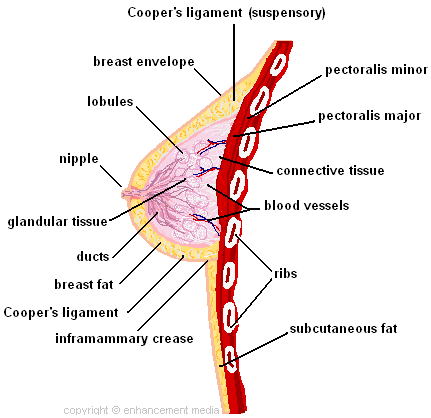Breast Development and Anatomy
The Female Breast and Breast Sizes
"B is for breasts, of which ladies have two; Once prized for the function, Now for the view."
Those words, penned by 20th century American writer Robert Paul Smith, pretty much sum up the cultural evolution of the female breast in society. The breast probably receives more attention than any other part of the female anatomy. Its size is just one attribute that can affect a woman's self-image, including her perceived sexual attractiveness. Adored, scrutinized and obsessed over by men and women alike, it's no wonder that this simple gland has risen to such prominence today.
In a perfect world, every woman would have full, firm, pert breasts in exactly the size she desires that would perpetually defy age, gravity, hormonal and weight fluctuations. Since this isn't the case, breast reduction surgery can help you achieve your goal of healthy, better-looking breasts.
Some women who are considering breast reduction surgery prefer to focus on the cosmetic side of the procedure; that is, what their breasts will look like afterwards. The more curious are drawn to the technical side of breast reduction surgery — everything from the anatomical makeup of the breast and its development to descriptions and sketches of the various procedures themselves. We've designed this website to provide information that you can pick and choose to suit your comfort level, and we've organized everything it to make it easy to find. Just click around and hopefully you'll come across exactly the right information for you.
Breast Development
In its most basic form, the breast is an organ of lactation. In fact, this source of life-giving milk for infants and small children has been highly regarded as a fertility symbol throughout history. Breasts are also known as mammaries or mammae, and it's easy to see the similarity between the words "mammae" and "Mama". "Mammae" is also at the root of the word "mammal", the category of animals that produce milk for their young.
Breast development begins very early on. Breast tissue, which is structurally identical in both sexes, begins developing in embryos at about 6 weeks after conception. It starts as a ridge of breast tissue (called, appropriately enough, the milk ridge), which runs from the armpit to the groin. Within about 3 weeks, growth of the milk ridge subsides in all areas except above the pectoral muscle. By 16 weeks postconception, the glands of the breast (lobules) are forming along with the intricate ductwork that will, perhaps, one day feed the embryo's own children.
The areola complex is comprised of the nipple (also called the mammary papilla) and the surrounding disc of pigmented skin (areola, or areolae in the plural form). The muscle structure under the areolae starts forming at the same time as the breast tissue, defining the fetal breast.
Occasionally, people are born with an extra nipple (sometimes more) along the milk ridge. These supernumerary nipples, or superfluous nipples, rarely develop into an extra breast.
Nipples and the areolae are made of erectile tissue that is rich with sensory nerves, making them sensitive to stimuli like touch and cold.
Boys and girls have identical breast structure until puberty, when things start to change. That's when girls begin producing estrogen and then progesterone, hormones that stimulate the sexual maturation process and breast development. The breasts will continue to enlarge and develop over the next 2 to 4 years, although some girls don't reach full adult breast maturity until the age of 20. While it is not uncommon for breasts to develop asymmetrically, they usually even out and resemble each other by the time they stop growing.
Even after puberty is over, breasts can continue to change. Since they are highly sensitive to hormonal fluctuations in the body (primarily estrogen and progesterone), these changes occur under a variety of circumstances: during pregnancy and breastfeeding; through the use of contraceptive pills, patches, or implants; or due to hormone or herbal supplementation. A hormonal imbalance in men can also result in breast development, a condition that is called gynecomastia.
Breast Anatomy
The diagram below provides a cross-section of a breast and chest, including the ribs and the muscles of the chest wall. In addition to glandular tissue, a breast contains fat, milk ducts, and ligaments.
The glands that produce milk and that make up breast tissue are arranged in lobes, which are subdivided into lobules. Each lobe has a thin tube called a milk duct that brings the milk to the nipple. There are between 15 and 25 lobes in each breast.

Cooper's ligament: the connective tissue that attaches the mammary gland to the overlying skin.
Pectoralis major: the larger chest muscle that arises from the collarbone, the sternum, most or all of the ribs, and the external oblique muscle and is inserted into the humerus bone of the upper arm. This is the largest muscle of the chest and it pulls the arm forward.
Pectoralis minor: a smaller chest muscle that lies beneath the pectoralis major, that arises from the third, fourth, and fifth ribs, and is inserted into the process of the shoulder blade. This muscle stabilizes the shoulder blade.
Connective tissue
Blood vessels
Ribs
Subcutaneous fat: fat that is just underneath the skin
Inframammary crease: the fold or crease under the breast where the breast meets the upper abdomen.
Breast fat: fatty tissue found above the glandular tissue of the breast.
Ducts: a duct is any tube that carries the secretion of a gland. In the breast, the ducts are lactiferous ducts, or milk ducts.
Glandular tissue
Nipple: the protuberance of the mammary gland that contains the openings of the milk ducts from which milk is drawn.
Lobules: the part of the breast where milk is produced. The lobules are gathered into lobes.
Breast envelope: the skin that surrounds the structure of the breast.
The breast is attached to the chest wall by the breast envelope, connective tissue and the Cooper's ligaments. During any surgery on the breast, care must be taken so as not to sever these ligaments. If the connective tissue or ligaments are disrupted, the breasts can droop.
Breast Size
 Breast size varies greatly from person to person. Usually it depends on such variables as the amount of breast tissue, body fat percentage, heredity, and if you have been pregnant. Breasts usually enlarge during pregnancy and stay enlarged until after breastfeeding is stopped. Then they usually shrink, a process called involution.
Breast size varies greatly from person to person. Usually it depends on such variables as the amount of breast tissue, body fat percentage, heredity, and if you have been pregnant. Breasts usually enlarge during pregnancy and stay enlarged until after breastfeeding is stopped. Then they usually shrink, a process called involution.
Other changes in breast size can result from having breastfed, estrogen and progesterone supplementation, hormonal disorders, menopause, and age. Natural changes in hormone levels that occur during the menstrual period can also cause the breasts to change in size. Some women own two sets of bras, one for during their period and the other for the rest of the month!
As we age, our skin thins out and we lose breast volume as the lobules shrink due to a drop in hormone levels. We also tend to lose body fat in areas where we want it, and that fat seems to migrate selectively to areas where we do not. C'est la vie!
Breast Shape and Symmetry
Virtually all women have breasts that are not symmetrical. In fact, the two sides of the body are never perfectly matched. Most women have breasts of slightly different sizes, just as their feet and hands differ slightly in size. My breasts were not symmetrical and were corrected with breast augmentation. If you have breasts that are visibly asymmetrical, you can have the problem corrected surgically, too.
Your nipples also may not exactly match. The areolae complex may be large, small, nonexistent, one larger than the other, bumpy, or have hair growth. Breasts are not usually perfect naturally, but they can be improved with surgery.
We Are All Different
We all want perfect breasts, but that ideal differs from person to person. I think we all have an idea of what looks good to us, but usually fuller, perkier breasts appeal to many of us because they are synonymous with vitality and youth. They say variety is the spice of life, and I think we should be allowed to have a preference for any breast shape we desire. Since most shapes can be achieved surgically, get whatever pleases you. Life is too short to be self-conscious about something that can be changed.
